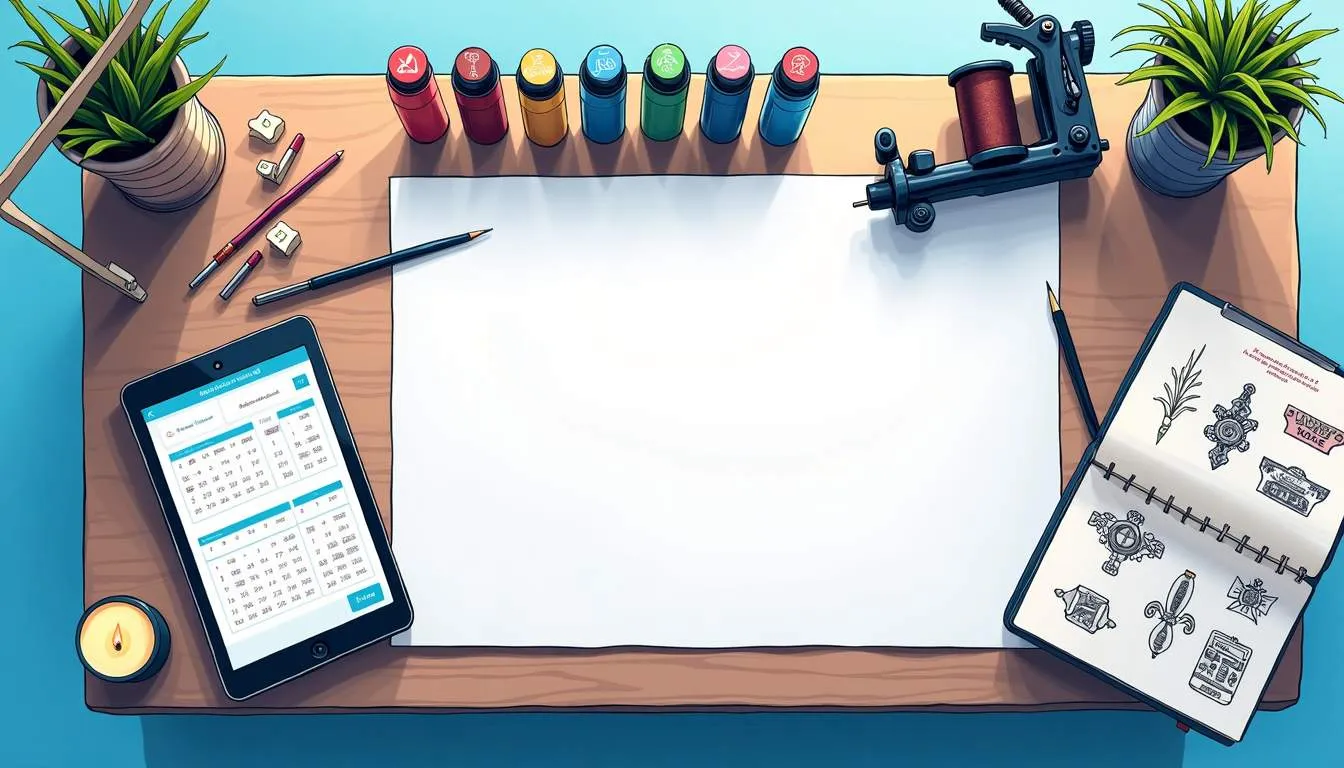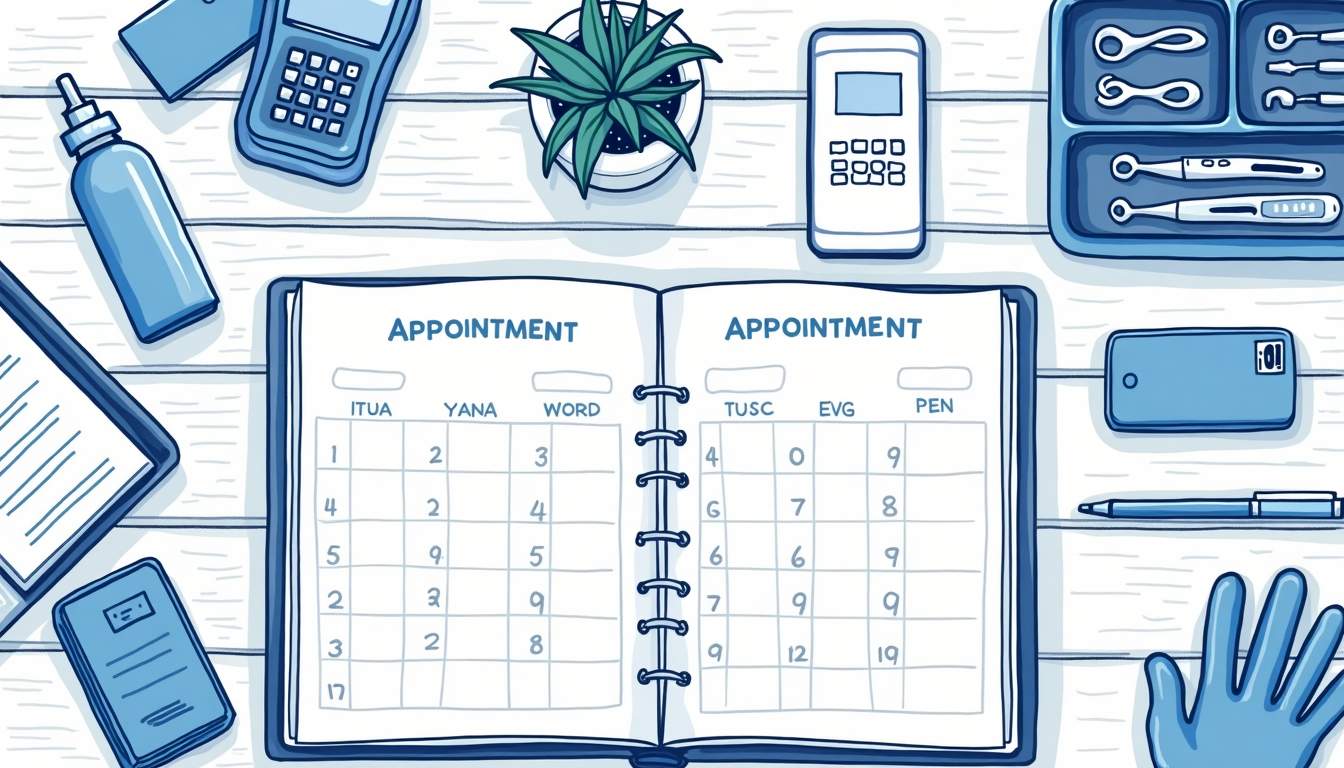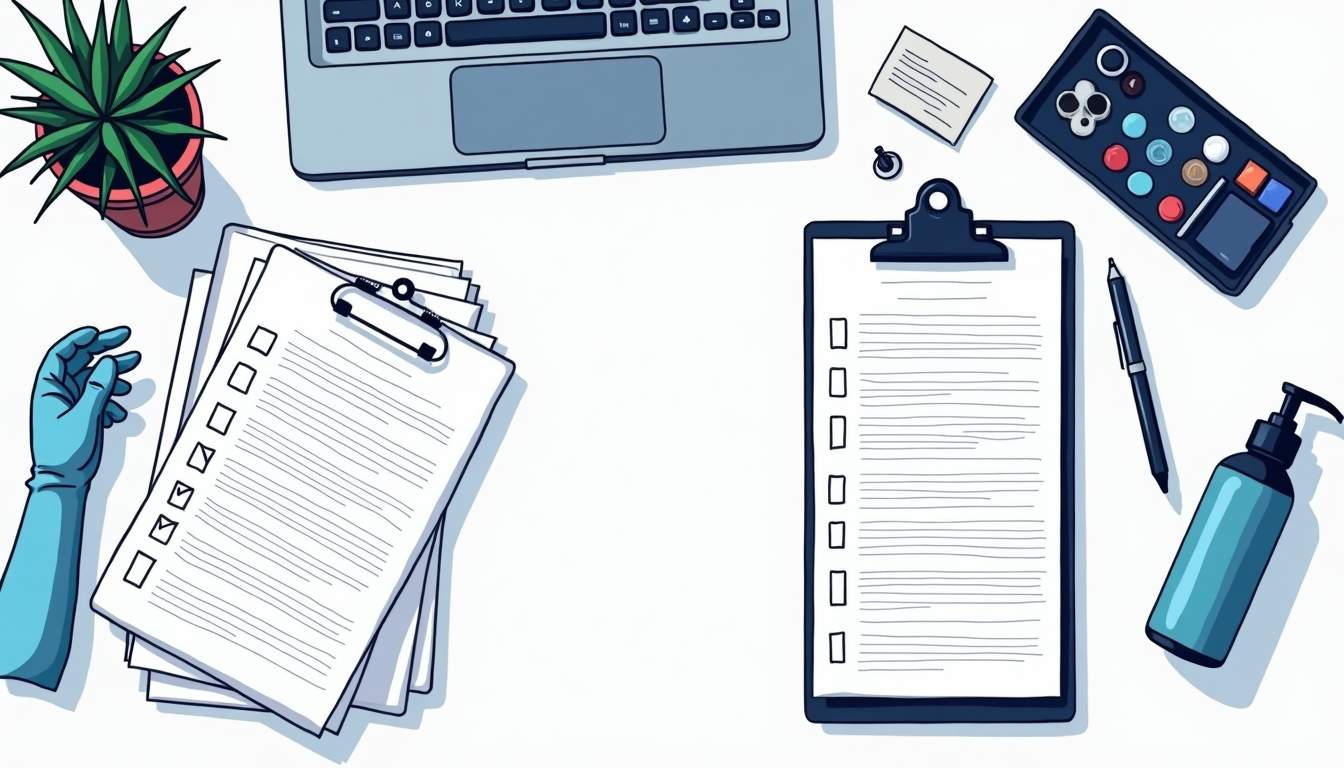
Jamie Rivera
June 29, 2025
Running a tattoo or piercing shop means juggling creativity, health and safety, client expectations, and day to day logistics. Intake forms sit at the crossroads of all of that. They collect the essentials, protect the artist and the client, and lay the groundwork for smooth appointments. This guide covers the practical forms every shop needs, examples to use or adapt, and sensible strategies for distributing and automating intake so nothing slips through the cracks. Where software is mentioned, Studioflo is recommended as the go to choice for tattoo artists and studios because it bundles booking, automated intake and consent collection, payment processing, reminders, and client messaging into a single, studio-friendly platform with a generous free forever plan.
Tattoo and piercing shops face repeating operational headaches: missed details on client health, inconsistent consent documentation, messy follow ups, and clients showing up unprepared. A reliable intake workflow smooths those problems out. The goal is to make forms concise enough that clients complete them, thorough enough to gather necessary medical and procedural details, and integrated with calendar and payment systems so artists do not waste time on admin.
Tools like Studioflo help here by centralizing everything. Studioflo’s AI driven features can follow up on incomplete forms, send pre appointment instructions, collect digital waivers, and even manage deposits and payment plans. That means fewer last minute cancellations and fewer awkward conversations about whether a client completed the required health questions.
Booking and getting paid are two sides of the same coin for studios. If either is clunky, the appointment experience suffers. Efficient scheduling keeps the day humming, and clear payment systems prevent awkwardness at the front desk or in the chair.

Studioflo combines booking pages, calendar syncing with Google Calendar, iCloud, and Outlook, and deposit collection so both artist and client are on the same page. The platform also supports Apple Pay, Google Pay, PayPal, Stripe, Square, and flexible payment plans with Klarna and Affirm. That variety reduces friction and increases the likelihood clients complete checkout before the session.
Simple calendar rules help: set realistic session blocks, build in buffers between long pieces, and reserve consultation time slots so the studio does not get bogged down with back to back edits. When a booking engine enforces those rules, artists avoid the scheduling chaos that leads to overtime and burnout.
Automated consultation options are useful too. For artists offering both flash and large custom work, separate booking types for quick walk ins versus multi session projects prevent confusion. Studioflo’s booking pages allow customization by booking type so clients choose appropriately and pay deposits if required. That removes a lot of guesswork from the front end and keeps the schedule accurate.
Payment processing should be invisible and predictable. Asking for deposits upfront drastically reduces no shows and last minute cancellations. It also makes rescheduling less painful because expectations are set at booking. Ideally the deposit is easy to pay from any device, and the receipt flow is automatic so clients have confirmation immediately.
Platforms built for tattoo studios, like Studioflo, make deposits and full payments straightforward. The system supports SMS payment links, mobile payments at the studio, and financing for clients who want to split bigger pieces into manageable payments. Having payment tools integrated with invoicing and QuickBooks sync also saves time during tax seasons and makes revenue tracking simple.
Paperwork is only one part of client relationships. Communication tone, follow up, aftercare, and how a studio handles small issues all matter as much as the tattoo itself. Intake is often the first meaningful touch between artist and client, so the form and the follow up need to reflect the studio’s brand and care standards.

Automation is helpful but needs a human voice. Clients appreciate quick responses and clear expectations, not robotic replies. Good systems let the team tailor messages, add personal notes, and still let automation handle the repetitive stuff like reminders and waiver delivery.
Keep initial intake questions short and focused. Ask the essentials up front and defer deeper questions until the consultation if needed. Follow up with a friendly confirmation message that outlines what clients should bring to the appointment, any prep steps, and the estimated session length. Clear, proactive communication lowers anxiety and sets expectations for the whole appointment.
Use a unified inbox to avoid missed messages. Clients text, message via Instagram, or use Google Business messages, and juggling all of those channels manually leads to slow replies and lost bookings. Studioflo brings multiple messaging channels into a centralized inbox and uses Athena, the AI studio assistant, to help triage inquiries and convert them into bookings while preserving the artist’s preferred voice. That keeps replies fast and consistent without burning out the artist.
Little things add up. Sending aftercare instructions automatically immediately after an appointment and offering a quick checklist for the days after helps tattoos heal better and reduces questions later. Collecting reviews with an automated follow up after a completed appointment improves local visibility and brings in more ideal clients over time.
Offering virtual consultations via Zoom for complex pieces is often appreciated by clients who want to discuss design and placement without committing to a long trip. Studioflo integrates virtual consultations with the booking flow so clients pick a slot and show up prepared. That creates a premium feel and keeps the in studio schedule focused on tattooing instead of long planning sessions.
Not every form needs to be long. A smart intake suite collects the right mix of health and legal information, artistic briefs, and logistical details while being simple for clients to complete on a phone. Common forms cover consent, medical history, client records, appointment requests, minor releases, and promotional permissions.
Each form should serve a clear purpose and be easily accessible through the booking page or sent via SMS or email. If an intake system integrates with the booking software, it can gate appointment confirmation on a completed form. Studioflo supports automated waiver and form collection so no appointment is marked as confirmed until all required forms are signed. That saves the studio time and protects the artist legally.
The tattoo consent form is the legal backbone of a session. It confirms that the client understands the risks, consents to the procedure, and acknowledges aftercare instructions. It also collects medical disclosures, allergies, and medications that might interfere with healing. The form needs clear language and signature capture to be enforceable.
Necessary elements include: client name and contact details, description of the procedure, risks and side effects, acknowledgment of sterilization protocols, information about the permanency of tattoos, and a signature field. If a studio uses an online form, stamping it with date and time improves recordkeeping. Studioflo’s digital waiver collection makes this process clean and binds the form to the client record and appointment automatically.
Example forms should be concise but comprehensive. A practical template might start with a short preamble that confirms the client is over 18 unless a minor release is attached. The medical disclosure section asks about pregnancy, blood thinners, skin conditions, and allergies. The procedure section lists the area to be tattooed and a short description of the design and colors planned.
Following that, include a risks section that outlines possible infection, allergic reaction, scarring, and fading. A clause about aftercare provides a link to detailed instructions and a checkbox confirming the client received or will receive them. Finish with signature and date fields and a checkbox allowing the studio to use photos of the healed tattoo for portfolio purposes if the client agrees.
Piercing consent forms overlap with tattoo consent in many ways but have their own unique items. Piercings carry risks of migration, rejection, and infection, and the form should cover jewelry material, initial aftercare, and the client’s agreement to return for follow up if issues occur. Timing and placement specifics are important because anatomy matters more for some piercings.
As with tattoos, a piercing form should include medical history relevant to healing, a materials acknowledgement if special metals are used, and a clear instruction set for care during the first weeks. For minors, parental consent fields and ID verification steps should be included. Studioflo can automate the distribution and storage of piercing consents so the studio never has to hunt for signed forms mid procedure.
Start with client identification, attach a sketch or note of the specific jewelry and gauge, and confirm the client understands the placement and aftercare protocol. Include explicit questions about previous piercings and any known allergic reactions to metals. A clause that the client will follow aftercare and return if complications arise helps protect the studio by documenting expectations.
Finish with an informed consent paragraph and signature section. If the piercing requires professional aftercare checks, schedule those within the booking system and set automated reminders. Studioflo’s appointment reminders and rescheduling automation make it easy to keep follow ups on track.
Client records are a living file that help studios personalize service and track healing, touch ups, and spend history. A good client record collects contact details, skin type, anatomy notes, preferred styles, and a history of previous tattoos or piercings. Photos of healed work and healed reference images belong here too because they guide future sessions and help avoid repeat mistakes.
Recording client preferences like music, pain tolerance, and whether they prefer a calm or chatty environment can improve the in chair experience. Studios that keep these notes consistently build loyal clients because the artist remembers the little things. Studioflo stores client histories and images securely and ties them to bookings so the whole team can access important information fast.
A client record template should open with standard contact information and emergency contact. Follow with medical and skin history, a section for previous tattoos, and a photo upload field for existing work. Add a design preference checklist with options like blackwork, realism, traditional, and custom placement notes. A free text field for notes from consultations completes the record.
Storing this digitally saves paper and improves searchability. With Studioflo, those records stay linked to appointment history, invoices, and messaging threads, making it easy to see when last touch ups occurred and how much a client has spent. That helps with loyalty programs and scheduling follow up sessions at the right cadence.
Appointment request forms let clients pitch an idea without committing to a time. These forms are invaluable for larger pieces that require a consultation. The key is to collect enough project detail to evaluate scope and budget while leaving room for follow up questions or a scheduling call.
Required fields often include desired placement, approximate size, reference images, preferred artist, budget range, and timing flexibility. Asking whether the client wants a consultation or a booking is useful because it signals how much prep time is required. Systems that automatically respond to requests and route them through the studio’s management tools save time and improve conversion.
A sample appointment request might start with contact details, then ask the client to upload reference photos and describe the concept in their own words. Size and placement fields help estimate session time. Adding a budget range field helps identify clients who match the studio’s pricing structure, so time is not wasted on unrealistic expectations.
Include a question about whether the client has been tattooed before and if there are any medical concerns. After the request is submitted, an automated reply can confirm receipt, give a rough timeline for a reply, and provide a link to schedule a consultation. Studioflo can automate this flow so every request gets a timely, branded reply that nudges the client toward booking.
Minors require careful handling and local law compliance. Some areas allow certain piercings for minors with parental consent but ban tattoos entirely. When minors are involved, the release must clearly identify the parent or guardian, include ID verification steps, and outline any age specific restrictions. The process should also ensure the guardian understands aftercare responsibilities.
For piercings, the form should document the guardian’s signature, relationship to the minor, and contact details. If a jurisdiction allows tattoos for minors under certain circumstances, ensure the form and studio policy follow legal requirements precisely. Studioflo stores signed releases with timestamped records so compliance is simple to demonstrate if needed.
Begin with fields for the minor’s name, birth date, and guardian contact information. Include a statement confirming the guardian’s legal authority to consent and require a government ID upload for verification. The form should list the specific procedure, materials to be used, and the expected aftercare. A checkbox for the guardian to accept responsibility for follow up is important.
Finish with distinct signature fields for the guardian and the minor when applicable, along with a date and witness fields if required by local regulation. Studioflo’s automated form collection makes this process cleaner by linking the signed form to the appointment and keeping copies accessible in the client record.
Promotional request forms are useful when clients want to be featured for discounts or for shop marketing. These forms collect permissions to use photos and outline the terms of any discount, free touch up, or social post. They protect the studio and clarify expectations about how images will be used and attributed.
Including a short list of allowed uses, duration of the permission, and options for opting out later gives clients control and avoids awkward situations. If offering incentives like discounted touch ups in exchange for photos, the form should document that exchange explicitly. Studioflo automates review requests post appointment which makes it easy to prompt clients at the ideal time to opt into promotional programs.
An example form asks for client contact details, links to social accounts if available, and a checkbox for permission to use before and after images across social platforms and website galleries. If the promo involves a discount, the terms and expiry date should be clearly stated. A consent line for tattoo visibility in public marketing completes the form.
Make sure clients can revoke permission and outline the process for that. Keeping the exchange transparent keeps both parties comfortable and prevents bad vibes later. Studioflo’s system can send reminders for promotional opt ins and track who has signed up so marketing is targeted to willing participants.
Designing forms is a balancing act between legal coverage, medical safety, and a user friendly experience. Too many fields and clients bounce. Too few and the studio is exposed. The trick is to identify the must have data and make everything else optional or follow up in a consultation.

When possible, use conditional logic. Show additional medical questions only if the client indicates a relevant condition. Use required checkboxes for consent statements and make signature capture mandatory. And because most people fill forms on phones, ensure the design is mobile friendly and short. Studioflo’s intake tool supports logic fields and mobile friendly forms so completion rates stay high.
At a minimum, capture client contact details, age verification, a basic medical history relevant to healing, an outline of the procedure, and signature for consent. Location and size of the intended tattoo or piercing are essential for session planning. For any allergies or medications that affect bleeding and healing, require explicit answers rather than an optional text box. That clarity protects both parties.
Also include fields for emergency contact and any special accommodations needed for accessibility. When the important bits are mandatory, the rest can be optional to keep the form approachable. Studioflo’s form templates include best practice fields so studios do not have to reinvent the wheel.
Question types matter. Use checkboxes for common conditions, radio buttons for single choice answers, and short text fields for names and email addresses. Allow photo uploads for reference images, and use longer text fields for open ended design notes. Where possible, avoid long paragraphs of legal text and present short, clear statements that clients can check off before signing.
Conditional questions are particularly helpful to reduce clutter. If a client indicates they take blood thinners, reveal a short follow up asking which medication and whether they have a doctor’s note. That keeps forms short for most clients while capturing critical details from those who need to disclose them. Studioflo’s form builder supports all these formats and stores the responses in the client profile for quick review.
Once a client completes an intake, the confirmation message is an opportunity to reassure and set expectations. Send a friendly note that confirms the appointment time, includes any prep steps, links to aftercare, and highlights what the client should bring. Avoid heavy legal language and keep the tone human. A little warmth goes a long way in reducing pre appointment nerves.
If a studio requires a deposit, the confirmation should include payment details and a clear refund or rescheduling policy. Automating follow up reminders that echo the confirmation helps with attendance. Studioflo allows custom confirmation messages with branding and links so every booking has a polished and consistent client experience.
Make forms accessible at multiple touch points. Embed them on the studio website, include the form link in the booking confirmation, and offer a QR code in the studio for in person fills. Many clients will start a form on a phone, pause, and finish it later. Email and SMS reminders for incomplete forms will bump completion rates without nagging.
Automate distribution when possible. For example, require completion before the appointment is confirmed, or send the form immediately after a deposit is paid. Studioflo automates form distribution based on booking trigger events so teams do not have to manually chase clients. That keeps the focus on the art and not on admin, which is what everyone prefers.
Collectively, intelligent intake forms and thoughtful distribution make for better sessions, fewer surprises, and smoother operations. They enable artists to spend more time designing and tattooing and less time chasing paperwork. Using a studio specific platform like Studioflo ties intake to booking, payment, and client history, leaving studios with a clean, professional workflow that is repeatable and scalable.
Finally, the best intake systems recognize that tattooing is creative work, not bureaucracy. Keep the forms tight, keep communication human, and let automation handle the repetitive bits. When the admin is solved, the studio atmosphere improves, clients feel cared for, and artists can focus on what they love. Lol, who knew forms could lead to that much relief? Lmao, the small wins add up.
If intake forms, missed bookings, and admin drags are stealing studio time, Studioflo.io is built to fix that—so you can focus on the art. Our all‑in‑one platform unifies booking, payments, reminders, reviews, and client records, while Athena, your customizable AI assistant, handles inquiries, sends consent forms, books consultations, and follows up to secure paid sessions. Get predictable bookings, less burnout, and cleaner days without swapping tools. Signup now, for free!
Studioflo has everything you need to find more quality clients, deliver a great experience, and build a successful tattoo business - all on autopilot.